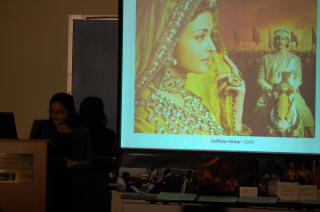
In 2010, Deepsikha Chatterjee (Hunter College/CUNY) and Cheri Vasek (University of Hawai’i, Manoa) received a grant from United States Institute of Theatre Technology to travel to India and study the process of Indian film production with focus on the work of costume designers. With the most number of films produced per annum in India, partly because of many regional language production centers, Indian films appeal to the one billion plus Indian people, South Asian populations, the Indian diaspora across the world, as well as many global viewers. International distributors have now taken an interest in these films with many being screened in the diverse New York City area and across United States.
Known for its dazzling costumes, sets, musical numbers and large casts, at first glimpse Indian films can seem superficially entertaining. While some viewers enjoy the departure from reality, Indian films also deal with complex issues such as social and religious structure, poverty, politics, gender issues, corruption and historical and mythological episodes that are represented through the costume and visual language. Through this diversity they speak to the rich and poor, the urban and rural populations. For over one hundred years Indian filmmakers have been creating images that influence how Indians view themselves and their history.

During this research, interviews were conducted with directors, actors, producers, assistant directors, costume designers, stylists, dress men, costume tailors, embroidery experts, dyers, shoe and armor makers, milliners and at film studios and rental houses at the various regional centers viz. Mumbai, Chennai, Hyderabad and Kolkata to understand the working of this complex industry. These visits and discussions were also documented in photos that have now been curated and displayed at an exhibit at the East West Gallery Honolulu, Hawai’i. Works from many Indian costumes designers like famed Bhanu Athaiya for her distinguished and Academy award winning work on Gandhi 1982, director Ashutosh Gowarikar and costume designer Neeta Lulla’s period costumes for historical film Jodhaa Akbar 2008 have been on display with original costumes, movie posters, designer sketches, photographs and film clips.
Indian films also have a larger impact with its fashion influences on the consumer market shortly after films are released. New York City very much like Indian cities of today was a large clothing manufacturing base, and parallels can be drawn to the fashion manufacturing industry and economics through this.

